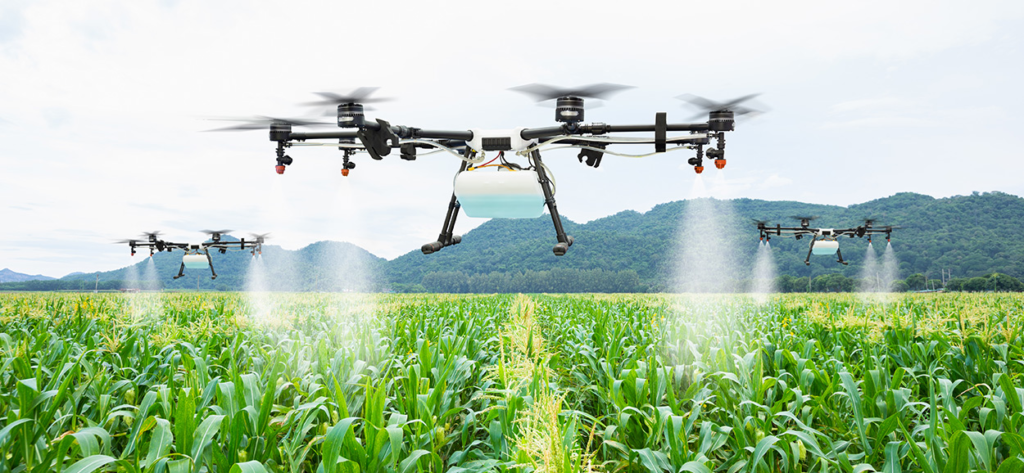AI in agriculture, which is also known as precision agriculture, basically is the application of artificial intelligence (AI) solutions in the field of agriculture. This technology is used for various tasks such as field harvesting, health monitoring, weed and pest control, detection of nutrient deficiencies in soil, and other tasks.

Benefits of Using AI in Agriculture
Agricultural businesses use such Artificial Intelligence solutions like machine learning, predictive analytics, and computer vision. But here are few of the benefits of using AI:-
- Automatic weeding
- Automatic harvesting
- Plant disease detection
- Improved soil health monitoring
- More efficient irrigation of farmland
- Application of pesticides and herbicides

Automatic weeding
We all are aware that weed use much of sunlight, nutrients, and it makes it easier for pests to harm the crops. Today, farmers have one more measures against this, the kind that replaces manual labour:
Here’s how a robot removes weeds:
- Robot drives through crop fields
- Cameras underneath show crops and weeds
- AI software identifies weeds and gives the command to remove them
- High-energy lasers eradicate weeds using thermal energy, without disrupting the soil

Automatic harvesting
Those are the words associated with the manual harvesting of many products. Due to lack of efficiency and slower speed, agricultural businesses are losing money due to lack of automation. That is why we now have automatic harvesting systems entering the market.
An automatic harvesting robot has:
- Camera
- AI software
- Mechanical arms
The software uses the camera to recognize vegetables or fruits and instruct the arms to pick them up. Although it may sound like such a system is slow, reports suggest that a robot is more efficient than humans, works 24/7, and is over 90% effective.
So far, robots for collecting peppers, lettuce, tomatoes, strawberries, apples, and other fruit and vegetables.
Plant disease detection

Between 20% to 40% of global food produced is lost because of the plant diseases and the pests.
That is why we have seen many plant diseases identification apps coming up all over the market. They use various sorts of AI algorithms to detect the health problems, and help the businesses to find and treat crops that have been damaged by the pathogens and pests.
The way this intelligent farming solution helps is really simple:
- Need to take a photo of the plant.
- The App will run the photo through an image recognition software.
- Then, this particular software will generate various information such as the disease, treatment recommendations, and/or identifies a pest plant
Plantix is one such app which is proving on how useful AI agriculture innovation can be. The developers behind this particular app have created an enormous database which includes 100,000 photos of sick plants, which is used by AI-powered image recognition to identify over 60 diseases.
Machine learning analysis.
AI-powered image recognition software compares input photos against its database of images of sick plants to generate results. The machine learning algorithm looks for particular characteristic pattern of plant diseases (mosaic-like discoloration, spots, etc.) to identify the problem.
Disease-detecting AI software can also be installed on cameras inside greenhouses, on drones, and other agricultural equipment. This way, farmers can recognize crop illnesses faster and respond with preventive measures. Already, drones with AI software are monitoring the health of fields such as vineyards all over the world.
Improved soil health monitoring
The ability to detect the diseases in the soil is extremely important to prevent the yield loss. Most farmers depend on the traditional soil analysis techniques, but the results are not always enough to prevent the diseases and other issues related with it.
Soil analysis with AI works like this:
- Soil sample is taken to identify all present microbes and content
- Machine learning algorithm compares the data from sample against a huge database of soil data
- The results often indicate the moisture level, nutritional deficiencies, concentration level, amount of microbes which are present in the sample, and other factors
- Specialists run these results and define the risks of some specific diseases as well as give us the treatment recommendations based on the soil content and microbes present in it.
Unlike the traditional methods, this agricultural AI innovation offers more comprehensive and accurate soil biology and chemistry analysis. That’s why farmers who use machine learning for soil analysis say they get more useful info about pathogens, which helps them inform their strategies instead of guessing what’s in the soil.
More efficient irrigation of farmland
Agriculture irrigation accounts for 70% of the water used worldwide. With crops requiring huge amounts of water, farmers are looking for ways to eliminate inefficiencies and achieve the optimal use of the resource.
Agriculture AI can help. Already, there are drones equipped with AI software that use advanced analytics and make high-resolution aerial imaging to collect information about irrigation systems on fields. Constant monitoring reveals problems like clogs and leaks as well as evaluates soil health.
Here’s how this AI agriculture system works:
- AI software is usually integrated with drones
- Drones are flown on a weekly basis over the fields
- Cameras which are installed onboard the drones will take aerial images of the field.
- AI software processes the footage and reveals important information like irrigation system problems and areas that needs more water or the use of fertilisers.
- Farmers can access the analysis which is done on their computers and make the decisions in order to prevent these problems (often weeks before they become apparent).
AI for agriculture mainly addresses these three most critical issues of farming: overuse of the chemicals, shortage of manual labour, and process of efficiency. The technology is making a steady progress, so many agricultural businesses are expected to operate using AI solutions within the next few years.

